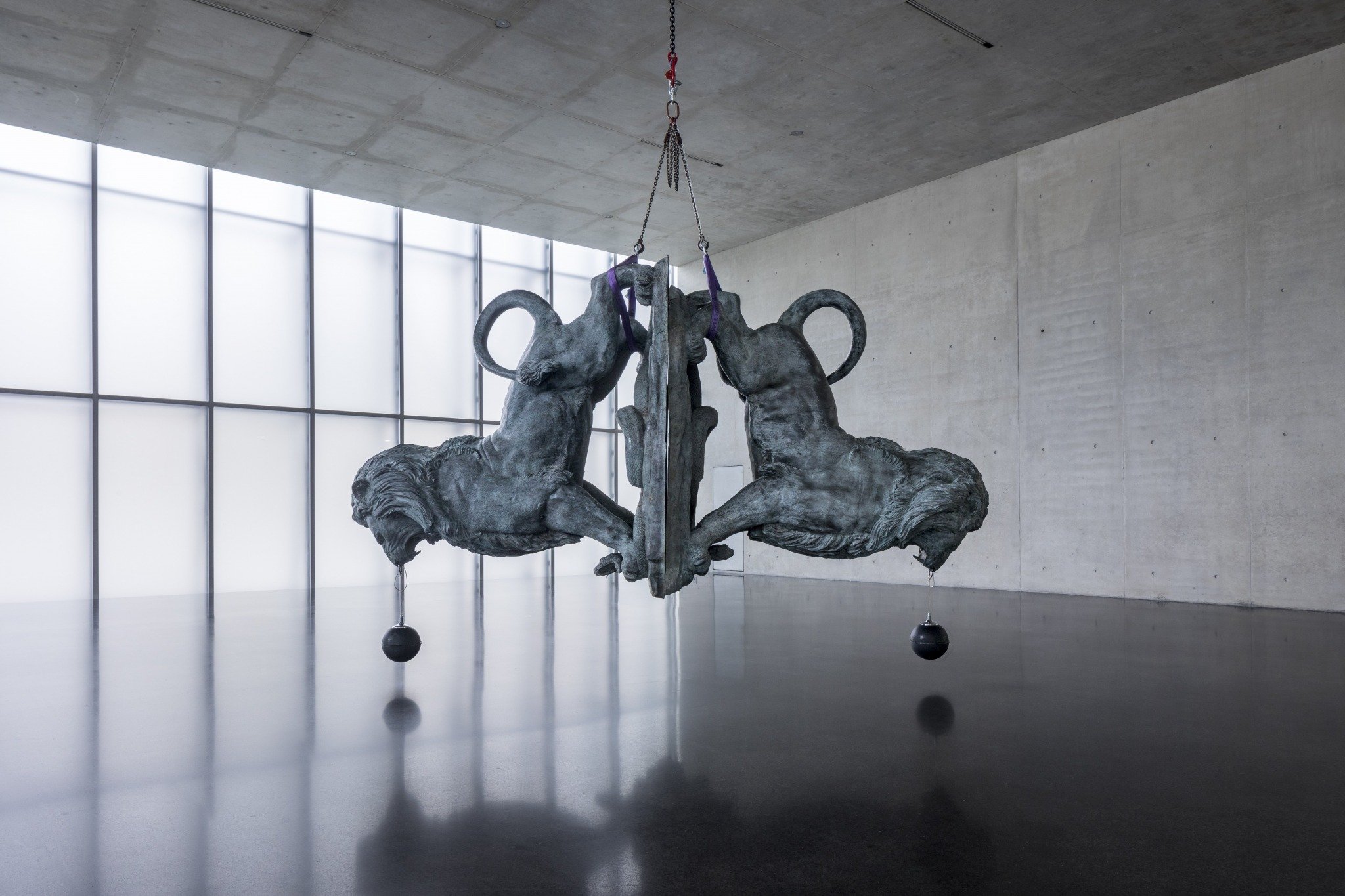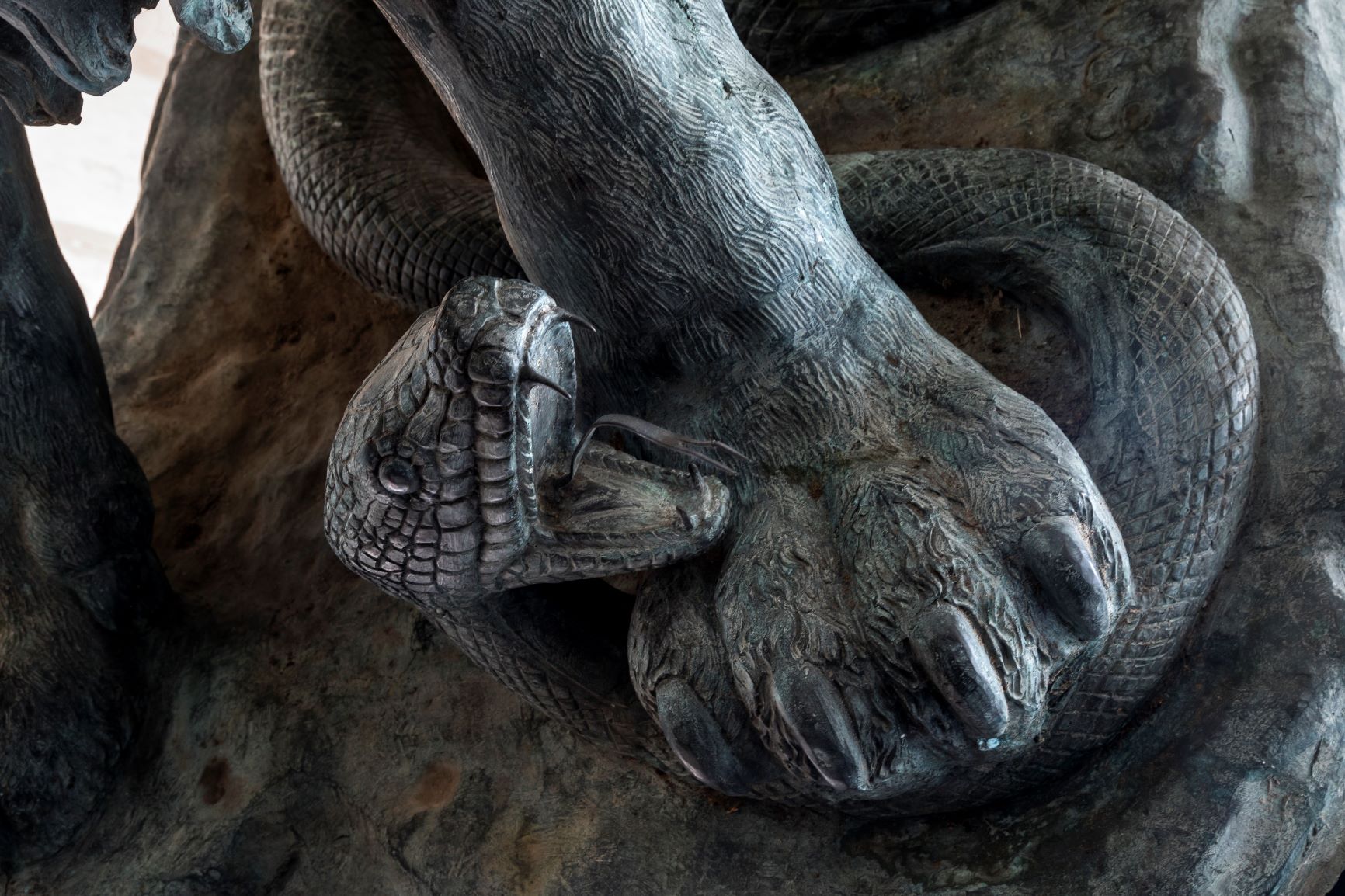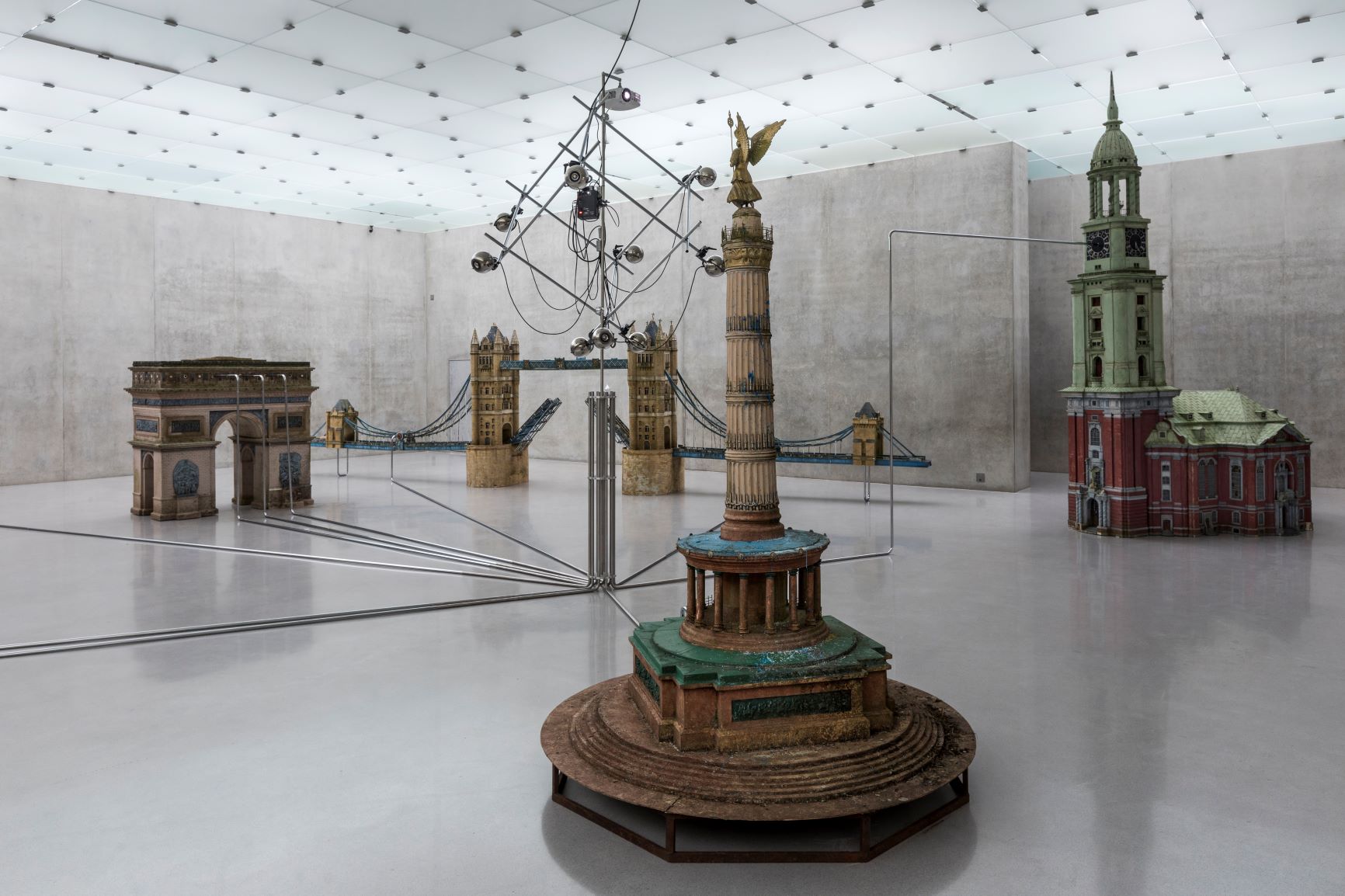Raphaela Vogel: unification of the manifold
Expressionism, monumentality and manifold in the works of Raphaela Vogel, before her solo exhibition in Milan.
We wrote this text a few weeks before the opening of Raphaela Vogel’s one-person gallery exhibition in Milan, that is not only her first in Italy but also her first gallery show (with Gregor Staiger in this case) after the main exhibition she had at the Kunsthaus in Bregenz at the end of 2019. In fact, there is no apparent relationship between the two shows, except the one there might be between the universal and the particular, the manifold and the one. Nevertheless, talking with the artist, this is precisely what has to be regarded as a fundamental aspect of her art practice: the scale of the work does not change due to the physical, social or psychological dimension of the space in which it is presented. A strongly three-dimensional artist like Raphaela Vogel would lead us to think that the scale of the space matters to her, especially after Bregenz. However, scale seems a quite marginal aspect in her work. Her personal vision is what really counts. The physical work is but a consequence of it. It is a bit like that painter who said he needed the same time to paint a 20 centimetre picture as a 2 metres one.
Sensuous representation of perfection is an express contradiction, and if the harmonious unification of the manifold is to be called perfection, it must be represented conceptually, else it is not fit to bear the name of perfection.
Immanuel Kant, The Critique of Judgement, First introduction, 1789/1790.

A poetic making
Almost never does Raphaela Vogel outsource the work to others, no matter how expert they are. Everything is born and proceeds from her own making. She even pilots the drone used for her videos, learning how to fly it just like a painter learns about brushes and a land artist about bulldozers (Michael Heizer, for example). For Raphaela Vogel the discourse on know-how is not reduced to mere technical capacity. This know-how is rather a way to put the artist’s attention at the centre of the work. It guarantees formal control and a sense of belonging to the maker, which is sometimes missing in the work of artists that outsource skills. We have made this point on other occasions. [See our writings on Lorenza Longhi and Lucy Stein. Ed].
In the era of controlling machines, Photoshop, TikTok, and surveillance capitalism, art understood as the expression of a technical skill is more likely to represent a defence of individuality, that is of our human uniqueness rather than ego. In this contemporary moment within the history of art, virtuosity is dead. There seems to be nothing that can bring it back to life. This does not detract from the intelligence of making though, the expressive potential of doing things by yourself.

Who is Raphaela Vogel?
Once this path has been taken, it is impossible not to try to focus on the protagonist of Raphaela Vogel’s visions, that is the artist Raphaela Vogel herself. In the case of Bregenz, the issue was also diligently addressed by Diedrich Diederichsen in the text he wrote for the catalog: he speaks of the existence of three types of self. The first, the cool self, is the one that fits into existing narratives, like those showed on one’s Instagram account for example. Then there is a transgressive self, which interprets the need for emancipation that pre-existing narratives generate. Finally, there is a shameless self, or the self responsible for the most extreme behaviors, whose only goal is self affirmation in every form and through every channel. According to Diederichsen, all these expressions of the self are part of the work of Raphaela Vogel in Bregenz, but only to be negated and overcome. They were entrusted with the expressive potential of the artist: a potential which is not that of the artist as a social or psychological archetype.

Even after placing this interpretation alongside ours, the basic question does not seem to dissolve. Are we perhaps faced with an expressionist work, and therefore with the visualization of an interior vision which, moreover, would be consistent with the cultural roots of the person who offers it? Or are we in the field of a dreamy invention, which does not represent a sentimental reflection on the world and experience, but generates its own values, perhaps in a subconscious secretly fed by the web? The artist responds by questioning the relation between person and persona, thus proving that the role we are talking about is, fortunately, beyond definition. Conscious and unconscious converge in a single kaleidoscope whose changeability and elusiveness fascinate.

Symbols
Raphaela Vogel told us that, for her, immersive installations are interesting only up to a certain point. In Bregenz as in Milan, the goal is therefore not to create an environment that is in itself concluded. Rather, the artist seems to challenge the idea of a space, and builds her own grammar upon this challenge. Again, her works exist regardless of the physical context. Yet they are organic, muscular, multidimensional, functional to each other, even when they have separate lives. In this sense, there is something that recalls medieval religious architecture, where everything is integrated and aimed at a purpose that obviously goes beyond architecture. And like the early Middle Ages, Vogel’s symbolic vocabulary is populated with animals and objects instead of characters, or perhaps actions (scene).

Raphaela Vogel, Der Traum des asexuellen Hirten, 2020. Oil, oil pastel, charcoal, iron-on foil, leather glue on goat- sheep- and deerskin, 279 x 144 cm. Courtesy the artist and BQ, Berlin. 
Raphaela Vogel, Stanton der Barbar, 2018. Oil, oil chalk, silicone and pen on deer, elk and goatskin, 288 x 212 cm | 113 1/2 x 83 1/2 in. Courtesy the artist & Galerie Gregor Staiger, Zurich.
Monumental Non-Monumental
If it is true that Raphaela Vogel’s works exclude the shell that contains them, it is also true that their apparent monumentality is not really such. If understood as a physical dimension, or extension in physical space, monumentality would be a relationship between the work and the context. That is, it would always be a relative measure. Yet art doesn’t work like that. In art, monumentality is an absolute category. For example, Rothko’s small paintings are monumental, and they remain monumental even alongside Richter’s biggest works, which instead have the opposite value: they are pleasantly intimate even when they are large. A similar thing is true for the city of Rome, which keeps its monumentality even next to the Eiffel Tower or Time Square, or like the Dolomites next to the Himalaya.
In the case of Vogel, the concept is the opposite, somewhat similar to Richter’s pieces: intimacy stays no matter how big is the work. Vogel’s canine muzzles painted on what could be Robinson Crusoe’s underwear, however large and intense, remain formally small, light, docilely elusive. And so far this is perhaps the most interesting aspect of Raphaela Vogel’s work. It generates a dimension of its own, albeit open and permeable.

La scultura senza qualità (an anonymous forward to the Milanese episode)
The luxuriant villa of the clown Grock in Imperia includes a garden that rampantly hides the exuberant details of its architecture. A curious drone finds the great paradox of a party paradise meant for the gathering of many people and the almost clichéd loneliness of the clown. The breathing of a song, accompanied by the clowns regular musical instrument, the accordeon, exhales the almost exoticist longing of this Swiss artist for the Italian south. The garden decoration withdraws from this full world into the gallery space: as an elegant sculpture, which lets the vase, the goblet as form, just barely be discerned before it vanishes into an absence of qualities in which only the sense of possibilities can unfold. The absence of qualities doesn’t just provide a person with endless possibilities, but also a sculpture.

Raphaela Vogel, La scultura senza qualità, 2019, installation view at CFAlive hosting Galerie Gregor Staiger, Milano. 
Raphaela Vogel, La scultura senza qualità, 2019, installation view at CFAlive hosting Galerie Gregor Staiger, Milano. 
Raphaela Vogel, La scultura senza qualità, 2019, installation view at CFAlive hosting Galerie Gregor Staiger, Milano.
The reconquest of primitive ritual
Sonia D’Alto
Nowadays there is a phenomenon that, in the scale of history, recalls medieval syncretism, reminiscent of Giambattista Vico’s corsi and ricorsi, in particular the relationship between the human and nature. Industrialisation, the invention of instruments and the creation of articulated language has contributed to the alienation from the body in the West, the animal and the natural- towards the cerebral culture.
Raphaela Vogel effectively reflects on this dual track: technology and technique on the one hand, human and animal nature on the other. The artist produces catafalques, belligerent machines, massive constructions such as subversive secretions. Her narratives are distinguished by fantastic animal annotations and references to natural sciences. The materials used reflect the dizziness of a possible balance during a transitional phase: the use of latest technologies such as drones and, simultaneously, the use of primitive materials such as goatskins, deer, or even materials such as textiles and metals (Isolation, 2016).
The artist calls her works “video-sculptures,” compositions that extend into space to present her feminine presence. Raphaela Vogel’s videos and video-sculptures are also features of the contemporary phenomenon of perpetual observation and video surveillance. For example, in performing one of her videos, the artist wears a controller connected to the drone so that it responds and follows her automatically. Unlike a social normalization of body functionalities, the artist uses the drone to propose a hybrid form that reconciles her with the animal.
Raphaela Vogel, Uterusland, 2018.
From the video Prokon (2014), the artist and the drone seem to participate in a form of occult, shamanic ritual. The drone acquires zoomorphic traits and the artist’s wild traits. When Vogel moves, she orchestrates everything, even shaking her cloak, in a obsessive way. In this video, as in others of the artist, we notice a sudden change of speed: the object slips into the überobject (the object appropriates space and performs it) and the artist is constantly swinging between dominance and submission. The video develops as a symbolic moment in the creative process, in accordance with the characters of Expanded Cinema. For example, in the video mogst du du, i can, (Do not ya like me, I like ya), 2014, Raphaela Vogel installs cameras on the hooves of a horse, an animal that symbolizes motricity. Inspired by Eadweard Muybridge and his work of decomposing the movement into photography, she extends this process to the film image until complete visual hybridization.
In the editing phase, the perspective captured by the cameras mounted on the hooves is combined to the footage made using drones. The result is the disappearance of the modern perspective and the fluctuation of the images. The typical transgression of medieval varietas involved the crisis of order and of status quo established in the phenomenon of image production. Similarly, the manner in which the video is made contributes to the “deconstruction” of the Eurocentric paradigm of the world’s vision.
Raphaela Vogel, Hochbett, 2016, Video 6:06.
“Every art is still today under the law of the mythical world” [Rosenzweig F., Der Stern der Erlösung, Kauffmann, Frankfurt am Main 1921]. The myth is the narration that comes after the rite [Cf. William Robertson Smith]. The rite is the paradigm of process and experience, it is a transformative operation that detects important classifications, categories, and contradictions of cultural processes. Raphaela Vogel shows the sedimentation of our society in an eternal return of symbolic corsi and ricorsi. The Hochbett (2016) video is an allegorical journey that begins with the artist taking on a falling scaffolding, and continues with the artist driving a flamboyant car overcoming monstrous beings that hinder her journey. The drone filming everything has now become a fantastic being, a sort of transcendental abstraction. The artist, dressed in a quilted epidermis, walks and explores a valley. In the final scene the phantasmagorical image breaks into a triptych that meets the iconic image of a cultish, symbolic statue. I Smell at Massacre (2016) reinvigorates this hybrid-mythological narrative. Here the artist is dressed in red, a symbol of passion, violence, and blood. This time, the drone carries not only a camera, but is also a bucranium- like in the metopes of Dorian temples – that interfaces with a flock of sheep, still containing a votive of mythological value, but located in a bunker covered with graffiti and in the perspective of the vision of the invaded artist while she handles the technological gadget.
Claude Lévi-Strauss recounts how certain Indigenous tribes delegated their expressive tasks: men painted figurative scenes or abstract motifs onto bison skin or upon the surfaces of other objects, while women would embroider decorative motifs with symbolic values. Raphaela Vogel enacts both types of production, thus renewing the status of the medieval artisan woman, artist, and even, to some extent, the head of corporations.

The artist transmits a sense of hubris; a feeling of arrogance unleashed by humankind caused by societies oblivious relationship to nature. She reflects upon this very feeling through the use of the myth of Marsyas and Apollo in the exhibition “She Shah” (2016-2017) at the Kunstverein Westfaelischer in Munster. The myth ends with the flaying of the satyr Marsyas, and the artist, in a gesture of retaliation, uses animal skins, altering them with oils and enamels (for example Die Wahrheit, 2016).
In Greek, hubrys is defined by excess as a hybrid. If hybridization refers to the heterogeneity of technique and multiplicity of elements, the actual dimension can appeal to an animal one, in organic and physiological terms. With Vogel we are confronted with a new mythology, a hybrid of primitive and neo-medieval, with the feminine and the animal. It is about reconsidering and reimagining certain categories: the divine, the human and the animal in order to reformulate the norm from marginalized perspectives.
February 2, 2022
